
|
New Kreutz sungrazer comet discovered from the spacecraft images. Terry Lovejoy succeeded to catch the comet on the ground on Mar. 10 at 9.2 mag. It will appear in the evening sky in late March in calculation. But actually, the comet must have evaporated at the perihelion passage on Mar. 15.
Date(TT) R.A. (2000) Decl. Delta r Elong. m1 Best Time(A, h)
Mar. 17 0 19.17 -3 44.5 0.900 0.166 8 5.0 19:40 ( 79, -9)
Mar. 24 2 1.98 -4 57.1 0.913 0.468 27 9.5 19:29 ( 90, 9)
|

|
Now it is 6.9 mag (Mar. 15, Juan Jose Gonzalez). It keeps bright as 7 mag and observable in excellent condition until April. Then it will be fading and will be unobservable in June. In the Southern Hemisphere, it is not observable now. It will be observable in the evening low sky from April to June.
Date(TT) R.A. (2000) Decl. Delta r Elong. m1 Best Time(A, h)
Mar. 17 11 35.37 69 16.1 1.317 1.926 112 6.8 23:45 (180,-14)
Mar. 24 10 21.05 64 37.4 1.393 1.981 110 7.0 22:08 (180, -9)
|

|
Now it is very bright as 9.5 mag (Feb. 11, Katsumi Yoshimoto). It will keep 10 mag until March, but it will be too low to observe. It is already unobservable in the Southern Hemisphere.
Date(TT) R.A. (2000) Decl. Delta r Elong. m1 Best Time(A, h)
Mar. 17 1 32.26 -0 31.1 1.943 1.138 26 11.2 19:40 ( 92, 3)
Mar. 24 2 0.30 0 6.8 1.982 1.181 26 11.5 19:29 ( 94, 5)
|
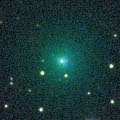
|
New comet discovered on Feb. 11. It was very bright as 10.6 mag (Feb. 12, A. Novichonok, V. Gerke). However, the comet is getting diffuse and fading rapidly after Feb. 20. It was still visible visually at 12.5 mag on Feb. 21 (Alan Hale). But it became completely invisible on Feb. 27 (Hidetaka Sato). The nuclear magnitude is fainter than 19 mag. It will approach to the sun down to 0.8 A.U. in mid March, but maybe it has been already disintegrated. It is already unobservable in the Southern Hemisphere. It will be unobservable soon also in the Northern Hemisphere. The comet has approached to the earth down to 0.2 A.U. in late January. Then it must have located in excellent position, but it has not been discovered.
Date(TT) R.A. (2000) Decl. Delta r Elong. m1 Best Time(A, h)
Mar. 17 0 56.68 14 46.3 1.614 0.805 23 12.1 19:40 ( 99,-13)
Mar. 24 0 50.24 14 7.7 1.745 0.830 15 12.5 19:29 ( 95,-18)
|

|
It was observed as bright as 13.9 mag in 2011 autumn (Oct. 19, Hidetaka Sato). It is not observable now. In the Northern Hemisphere, it will be observable again in 2012 summer, when it will be fainter than 15 mag. In the Southern Hemisphere, it will never be observable again.
Date(TT) R.A. (2000) Decl. Delta r Elong. m1 Best Time(A, h)
Mar. 17 23 27.60 21 3.6 2.455 1.587 22 12.7 4:35 (262,-26)
Mar. 24 23 48.67 23 57.9 2.508 1.641 23 12.8 4:42 (257,-25)
|

|
Now it is 12.6 mag (Mar. 13, Jakub Cerny). In the Northern Hemisphere, it keeps observable at 11-12 mag in good condition until March, but it will be unobservable in April. It is already low in the Southern Hemisphere.
Date(TT) R.A. (2000) Decl. Delta r Elong. m1 Best Time(A, h)
Mar. 17 3 4.00 13 59.6 2.553 2.076 50 13.0 19:40 (117, 12)
Mar. 24 3 19.49 14 54.6 2.624 2.091 47 13.1 19:29 (117, 11)
|

|
Big asteroid discovered in 1906. It suddenly showed the cometary activity on Dec. 11, 2010, probably due to an impact of a small object. It was very bright as 11.5 mag visually (Dec. 17, 2010, Juan Jose Gonzalez). Now it is 14.1 mag (Jan. 3, Hidetaka Sato). It has already turned to be stellar.
Date(TT) R.A. (2000) Decl. Delta r Elong. m1 Best Time(A, h)
Mar. 17 16 49.42 -15 53.8 2.029 2.461 103 13.5 4:35 (204, 69)
Mar. 24 16 54.30 -16 19.8 1.941 2.457 109 13.4 4:42 (184, 71)
|
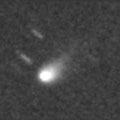
|
It is expected to be bright as 9 mag from 2012 to 2013. Now it is 14.1 mag and visible visually (Feb. 22, Sandor Szabo). In the Northern Hemisphere, it keeps observable in good condition for a long time until 2012 autumn when the comet brightens up to 10 mag. In the Southern Hemisphere, it is hardly observble before the perihelion passage. But it becomes observable in good condition since 2013 after the perihelion passage. By the way, Juan Jose Gonzalez reported it was very bright as 11.5 mag visually on Mar. 15.
Date(TT) R.A. (2000) Decl. Delta r Elong. m1 Best Time(A, h)
Mar. 17 15 42.93 53 5.6 3.449 3.892 109 13.6 4:04 (180, 2)
Mar. 24 15 40.78 54 4.5 3.371 3.829 109 13.5 3:34 (180, 1)
|

|
Now it is bright as 12.8 mag and visible visually (Mar. 14, John Drummond). It keeps bright as 13-14 mag for a long time after this until 2013. It is not observable in the Northern Hemisphere, but it is observable in good condition in the Southern Hemisphere.
Date(TT) R.A. (2000) Decl. Delta r Elong. m1 Best Time(A, h)
Mar. 17 2 39.17 -66 43.4 5.711 5.483 71 13.5 19:40 ( 29, 39)
Mar. 24 2 48.58 -65 8.6 5.710 5.489 72 13.5 19:29 ( 31, 39)
|
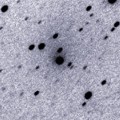
|
Small outburst occured on Feb. 17 (Richard Miles). Now it is visible visually at 13.8 mag (Mar. 15, Juan Jose Gonzalez).
Date(TT) R.A. (2000) Decl. Delta r Elong. m1 Best Time(A, h)
Mar. 17 12 27.33 -13 3.3 5.303 6.260 162 13.6 0:49 (180, 68)
Mar. 24 12 24.28 -12 49.5 5.280 6.259 168 13.6 0:19 (180, 68)
|

|
It brightened up to 17.1 mag in late June in 2011 (June 24, J. F. Hernandez). The condition of this apparition is bad, and it is not observable around the perihelion passage. It is appearing in the morning sky in the Southern Hemisphere, but it locates extremely low. It will not be observable until June in the Northern Hemisphere, when the comet will be 15.5 mag.
Date(TT) R.A. (2000) Decl. Delta r Elong. m1 Best Time(A, h)
Mar. 17 22 29.00 -16 18.0 2.651 1.793 24 13.8 4:35 (285, 6)
Mar. 24 22 46.05 -14 48.1 2.656 1.825 26 13.9 4:42 (282, 9)
|

|
Now it is bright as 13.3 mag (Mar. 5, F. Kugel). It keeps 13-14 mag and observable in good condition until September.
Date(TT) R.A. (2000) Decl. Delta r Elong. m1 Best Time(A, h)
Mar. 17 18 9.34 -13 51.3 5.137 5.136 84 13.9 4:35 (238, 57)
Mar. 24 18 6.22 -13 45.7 5.001 5.134 92 13.8 4:42 (224, 62)
|

|
Although it has been unobservable for a while, now it is appearing in the morning sky. Now it is 14.0 mag (Mar. 5, Jakub Cerny). After this, it will be observable in good condition in the Southern Hemisphere while fading gradually. It will locate somewhat low in the Northern Hemisphere. In 2011, some visual observers reported it was very bright as 10-12 mag.
Date(TT) R.A. (2000) Decl. Delta r Elong. m1 Best Time(A, h)
Mar. 17 21 8.18 -14 33.0 3.217 2.558 41 14.2 4:35 (273, 22)
Mar. 24 21 20.97 -14 22.9 3.190 2.590 45 14.2 4:42 (270, 26)
|

|
It was expected to keep 14-15 mag for a long time from 2011 summer to 2012 summer. However, it is lost. It was observed only during two days in 2010 June. So the orbital elements are extremely uncertain. The condition is good in the Southern Hemisphere. But in the Northern Hemisphere, it is not observable until August.
Date(TT) R.A. (2000) Decl. Delta r Elong. m1 Best Time(A, h)
Mar. 17 2 30.89 -45 35.7 2.729 2.339 56 14.4 19:40 ( 56, 36)
Mar. 24 2 48.30 -42 0.6 2.767 2.355 55 14.4 19:29 ( 60, 35)
|

|
It reached up to 9.7 mag with a large bright coma in last autumn (Oct. 29, Juan Jose Gonzalez). It will be fading after this. Outburst occured on Jan. 2, but it has been already diffuse and fading. It has already faded down to 12.8 mag (Feb. 20, Sandor Szabo). It will be unobservable in late March in the Northern Hemisphere, or late April in the Southern Hemisphere.
Date(TT) R.A. (2000) Decl. Delta r Elong. m1 Best Time(A, h)
Mar. 17 3 11.68 -7 17.3 3.540 3.017 51 14.4 19:40 (100, 27)
Mar. 24 3 16.68 -7 37.2 3.672 3.074 46 14.6 19:29 ( 98, 25)
|

|
Now it is 14.3 mag (Mar 13, Jakub Cerny). It is already unobservable in the Northern Hemisphere. In the Southern Hemisphere, it locates extremely low now. But it will be getting higher gradually after May. It is expected to be observable at 11-13 mag for a long time from 2012 summer to 2013 summer. It will be observable in excellent condition in the Southern Hemisphere. But it is not observable until 2013 January in the Northern Hemisphere.
Date(TT) R.A. (2000) Decl. Delta r Elong. m1 Best Time(A, h)
Mar. 17 1 23.24 -31 55.0 3.952 3.226 37 14.6 19:40 ( 63, 18)
Mar. 24 1 28.41 -31 56.4 3.898 3.170 37 14.5 19:29 ( 62, 16)
|

|
Now it is visible visually at 14.3 mag (Jan. 20, Sandor Szabo). It is expected to be 13 mag and will be observable in good condition in 2013. In the Northern Hemisphere, it will be getting higher gradually in the morning sky, and keeps observable for a long time. It is not observable in the Southern Hemisphere.
Date(TT) R.A. (2000) Decl. Delta r Elong. m1 Best Time(A, h)
Mar. 17 23 16.01 48 31.3 7.215 6.624 50 14.6 4:35 (231,-35)
Mar. 24 23 18.57 48 39.5 7.218 6.602 48 14.6 4:42 (229,-30)
|

|
Now it is bright as 13.9 mag (Mar. 14, Jakub Cerny). Although it was extremely faint as 20.5 mag at the recovery in 2010 autumn, it brightened rapidly. It will keep 14 mag and observable in good condition for a long time from 2012 to 2013. But it locates somewhat low in the Northern Hemisphere in 2013. By the way, Juan Jose Gonzalez reported it was very bright as 11.7 mag visually on Mar. 15.
Date(TT) R.A. (2000) Decl. Delta r Elong. m1 Best Time(A, h)
Mar. 17 13 30.41 13 1.8 2.402 3.314 152 14.9 1:52 (180, 42)
Mar. 24 13 26.44 13 33.7 2.359 3.298 156 14.8 1:21 (180, 42)
|

|
Now it is 15.0 mag (Feb. 13, V. Gerke, S. Plaksa, A. Novichonok, D. Chestnov). In the Northern Hemisphere, it keeps observable at 14-15 mag in good condition until early 2013. In the Southern Hemisphere, it is not observable until late 2012.
Date(TT) R.A. (2000) Decl. Delta r Elong. m1 Best Time(A, h)
Mar. 17 20 18.28 42 20.4 2.869 2.595 64 15.1 4:35 (220, -5)
Mar. 24 20 27.45 46 5.9 2.782 2.551 66 15.0 4:42 (215, -5)
|
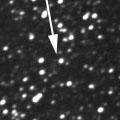
|
It is expected to be a great comet of 0 mag in 2013 spring. Now it is 14.5 mag (Feb. 13, R. Naves, M. Campas), brightening well. In 2012, it keeps observable until summer while brightening gradually. It locates somewhat low in the Northern Hemisphere.
Date(TT) R.A. (2000) Decl. Delta r Elong. m1 Best Time(A, h)
Mar. 17 17 0.84 -24 9.7 4.998 5.265 100 15.7 4:35 (226, 75)
Mar. 24 17 0.15 -24 23.5 4.810 5.192 107 15.6 4:42 (195, 79)
|

|
In the Southern Hemisphere, it is appearing int he morning sky. It will be observable at 15-16 mag in good condition for a long time until 2013 summer. It is not observable at all in the Northern Hemisphere.
Date(TT) R.A. (2000) Decl. Delta r Elong. m1 Best Time(A, h)
Mar. 17 19 46.36 -44 39.7 4.376 4.114 68 15.8 4:35 (300, 49)
Mar. 24 19 53.96 -46 1.8 4.258 4.095 73 15.8 4:42 (302, 54)
|
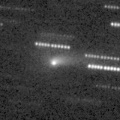
|
It reached up to 11-12 mag in 2011 autumn. Now it is fading. It has already faded down to 15.8 mag (Feb. 17, J. Vales). It keeps observable in good condition until May when it becomes fainter than 18 mag. It locates somewhat low in the Southern Hemisphere.
Date(TT) R.A. (2000) Decl. Delta r Elong. m1 Best Time(A, h)
Mar. 17 12 7.75 30 26.3 1.186 2.110 150 16.3 0:30 (180, 25)
Mar. 24 12 1.51 31 0.8 1.249 2.158 147 16.5 23:51 (180, 24)
|

|
It is expected to keep 13 mag and observable in good condition in the Northern Hemisphere for a long time from 2013 to 2014. Now it is 16.7 mag (Feb. 4, P. Dupouy). It keeps observable at 17-18 mag in good condition until June.
Date(TT) R.A. (2000) Decl. Delta r Elong. m1 Best Time(A, h)
Mar. 17 10 53.95 5 10.7 5.576 6.546 166 16.9 23:11 (180, 50)
Mar. 24 10 49.10 6 8.2 5.567 6.500 157 16.9 22:39 (180, 49)
|
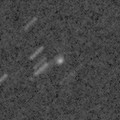
|
Now it is 16.5 mag (Feb. 4, V. Gerke, S. Plaksa, A. Novichonok, D. Chestnov). In the Northern Hemisphere, it keeps observable at 16-17 mag in good condition for a long time from 2012 to 2013. It is not observable in the Southern Hemisphere.
Date(TT) R.A. (2000) Decl. Delta r Elong. m1 Best Time(A, h)
Mar. 17 11 22.46 63 30.3 3.556 4.113 117 16.9 23:39 (180, -9)
Mar. 24 11 1.45 64 44.7 3.595 4.082 112 16.9 22:50 (180,-10)
|
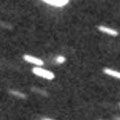
|
Now it is 17.1 mag (Feb. 11, P. Dupouy). It keeps observable at 17 mag for a long time from 2011 to 2013. In 2012, it keeps observable in good condition until early September.
Date(TT) R.A. (2000) Decl. Delta r Elong. m1 Best Time(A, h)
Mar. 17 16 26.80 2 22.1 5.218 5.640 110 17.1 4:35 (185, 53)
Mar. 24 16 21.78 3 2.6 5.103 5.636 117 17.0 4:15 (180, 52)
|
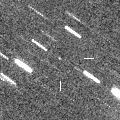
|
Now it is 18.4 mag (Mar. 13, Catalina Sky Survey). A bit fainter than expected by 1 mag, but brightening rapidly now. It is expected to reach up to 16.5 mag from spring to summer. However, it locates extremely low in the Southern Hemisphere. In the Northern Hemisphere, it locates high now. But it will be getting lower gradually in the evening sky, and will be unobservable in June.
Date(TT) R.A. (2000) Decl. Delta r Elong. m1 Best Time(A, h)
Mar. 17 3 51.25 19 56.8 1.912 1.714 63 17.3 19:40 (129, 16)
Mar. 24 4 8.76 20 34.6 1.944 1.693 60 17.1 19:29 (130, 16)
|
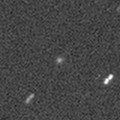
|
Now it is 17.8 mag (Feb. 11, C. Rinner, F. Kugel). It will brighten up to 13.5 mag from summer to autumn. It keeps observable for a long time until December. In the Northern Hemisphere, it locates high until spring. But after that, it keeps locating low in the evening. In the Southern Henmisphere, it keeps locating low all through the time.
Date(TT) R.A. (2000) Decl. Delta r Elong. m1 Best Time(A, h)
Mar. 17 11 18.00 32 54.6 2.062 2.952 147 17.3 23:35 (180, 22)
Mar. 24 11 11.58 34 5.3 2.028 2.877 141 17.1 23:01 (180, 21)
|

|
It brightened up to 13-14 mag and became visible visually from 2007 to 2009. Now it is fading. But it is still bright as 16.1 mag (Feb. 13, Gerke, S. Plaksa, A. Novichonok, D. Chestnov). In the Northern Hemisphere, it keeps observable in excellent condition until early summer in 2012. In the Southern Hemisphere, it locates extremely low only.
Date(TT) R.A. (2000) Decl. Delta r Elong. m1 Best Time(A, h)
Mar. 17 10 8.13 40 34.1 10.835 11.558 134 17.3 22:26 (180, 14)
Mar. 24 10 4.50 40 32.4 10.943 11.594 128 17.3 21:55 (180, 15)
|

|
It is bright as 16.1 mag still now (Jan. 23, Hidetaka Sato). After a small outburst in early December, it keeps its brightness without fading. It will keep 16-17 mag some more time. It is observable in good condition in the Southern Hemipshere. It keeps locating very low in the Northern Hemisphere.
Date(TT) R.A. (2000) Decl. Delta r Elong. m1 Best Time(A, h)
Mar. 17 15 19.05 -42 18.0 1.707 2.316 115 17.4 3:40 ( 0, 83)
Mar. 24 15 14.58 -42 37.8 1.707 2.393 122 17.5 3:09 ( 0, 82)
|
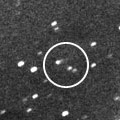
|
Now it is 16.7 mag (Feb. 20, A. Diepvens). It will brighten up to 13 mag in 2014. In 2012, it is observable at 17 mag in good condition in spring.
Date(TT) R.A. (2000) Decl. Delta r Elong. m1 Best Time(A, h)
Mar. 17 11 11.59 16 52.1 3.358 4.316 162 17.5 23:29 (180, 38)
Mar. 24 11 7.32 17 9.7 3.376 4.302 155 17.5 22:57 (180, 38)
|

|
It has not been observed since 2011 March. But it must be already bright as 18 mag. It will brighten up to 17 mag and will be observable in good condition from spring to summer.
Date(TT) R.A. (2000) Decl. Delta r Elong. m1 Best Time(A, h)
Mar. 17 18 22.44 -15 29.5 1.957 2.057 81 17.6 4:35 (244, 55)
Mar. 24 18 34.82 -14 46.4 1.891 2.061 85 17.5 4:42 (236, 59)
|
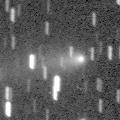
|
It had been fading after the perihelion passage in 2010 October, but it brightened again in outburst on Apr. 5, 2011. It reached up to 14.7 mag in May (May 28, Hidetaka Sato). It is bright as 17.9 mag still now, much brighter than expected (Mar. 11, V. Gerke, A. Novichonok, S. Plaksa). It locates low in the Southern Hemisphere. But in the Northern Hemisphere, it keeps observable in good condition after this. It will keep 18 mag for a while.
Date(TT) R.A. (2000) Decl. Delta r Elong. m1 Best Time(A, h)
Mar. 17 13 36.56 20 20.0 3.125 3.998 147 17.6 1:58 (180, 35)
Mar. 24 13 31.79 20 51.2 3.127 4.025 150 17.7 1:26 (180, 34)
|
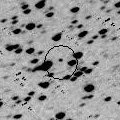
|
Peculiar asteroid moving along a cometary orbit. Now it is 17.4 mag (Jan. 4, Catalina Sky Survey). It keeps observable at 18 mag for a long time from 2008 to 2014.
Date(TT) R.A. (2000) Decl. Delta r Elong. m1 Best Time(A, h)
Mar. 17 7 4.22 19 47.7 6.325 6.707 108 17.7 19:40 (175, 35)
Mar. 24 7 2.74 20 21.5 6.451 6.715 101 17.8 19:29 (170, 34)
|

|
It has not been observed since 2011 April. But it must be already bright as 18 mag. It tends to brighten after the perihelion passage. It keeps observable at 17 mag from 2012 to 2013. It locates somewhat low in the Northern Hemisphere.
Date(TT) R.A. (2000) Decl. Delta r Elong. m1 Best Time(A, h)
Mar. 17 16 40.47 -14 55.8 2.757 3.176 105 17.8 4:35 (198, 69)
Mar. 24 16 43.67 -15 0.3 2.659 3.169 111 17.7 4:37 (180, 70)
|
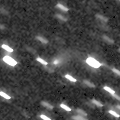
|
Now it is 17.2 mag (Feb. 13, V. Gerke, S. Plaksa, A. Novichonok, D. Chestnov). It keeps observable in good condition for a while after this. But it will be fainter than 18 mag in late March.
Date(TT) R.A. (2000) Decl. Delta r Elong. m1 Best Time(A, h)
Mar. 17 7 26.81 3 42.1 1.893 2.481 114 17.8 19:46 (180, 51)
Mar. 24 7 31.56 4 10.5 1.983 2.499 109 18.0 19:29 (177, 51)
|
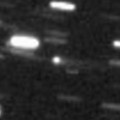
|
Now it is 17.5 mag (Feb. 10, P. Dupouy). It keeps observable at 18 mag for a long time until 2013.
Date(TT) R.A. (2000) Decl. Delta r Elong. m1 Best Time(A, h)
Mar. 17 5 15.91 25 17.2 3.912 3.924 83 17.8 19:40 (149, 23)
Mar. 24 5 21.21 25 18.5 4.016 3.926 77 17.9 19:29 (147, 22)
|

|
New Kreutz sungrazer comet discovered on the ground after 41-year blank since Comet C/1970 K1 (White-Ortiz-Bolelli). It approached nearly to the surface of the Sun on Dec. 16, and reached -4 mag or brighter at best. Then it appeared in the morning sky in the Southern Hemisphere, and it became a great comet with a bright long tail of 30-40 degrees. However, the nucleus of the comet was not visible at all, fainter than 19 mag (Jan. 2, Robert McNaught). Probably the comet itself has already disappeared and only the remnant is visible. The tail became extremely faint, but detectable by photos still now with an excellent sky condition (Mar. 12, Lester Barnes).
Date(TT) R.A. (2000) Decl. Delta r Elong. m1 Best Time(A, h)
Mar. 17 5 17.51 -10 42.6 2.132 2.230 82 17.9 19:40 (124, 53)
Mar. 24 5 23.81 -9 6.1 2.335 2.341 78 18.4 19:29 (122, 50)
|
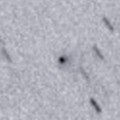
|
It became brightest after the perihelion passage as predicted, and reached up to 16.0 mag (Feb. 13, V. Gerke, S. Plaksa, A. Novichonok, D. Chestnov). It is fading now, but still bright as 16.8 mag (Mar. 11, V. Gerke, A. Novichonok, S. Plaksa). It is observable in excellent condition in the Northern Hemisphere. It locates somewhat low in the Southern Hemisphere. It may be brighter than this ephemeris.
Date(TT) R.A. (2000) Decl. Delta r Elong. m1 Best Time(A, h)
Mar. 17 10 34.82 32 29.8 2.106 2.972 144 17.9 22:52 (180, 23)
Mar. 24 10 30.18 32 25.8 2.193 3.012 138 18.0 22:20 (180, 23)
|

|
It reached up to 15.3 mag in early summer in 2011 (June 19, Toshiyuki Takahashi). Now it is fading. It has already faded down to 17.5 mag (Feb. 20, P. Dupouy). It will be fainter than 18 mag in March. I will locate high in the Southern Hemishere, but somewhat low in the Northern Hemisphere after this.
Date(TT) R.A. (2000) Decl. Delta r Elong. m1 Best Time(A, h)
Mar. 17 16 24.44 -22 18.5 2.368 2.847 108 17.9 4:35 (190, 77)
Mar. 24 16 25.60 -22 52.4 2.307 2.877 115 18.0 4:19 (180, 78)
|

|
It was observed so bright as 9.4 mag in September (Sept. 22, Chris Wyatt). It has got diffuse and faded rapidly. It has already faded down to 18 mag (Feb. 14, V. Gerke, S. Plaksa, A. Novichonok, D. Chestnov). It is observable in good condition in the Northern Hemisphere. It is not observable in the Southern Hemisphere. Sandor Szabo reported it was visible visually at 15.4 mag on Feb. 22.
Date(TT) R.A. (2000) Decl. Delta r Elong. m1 Best Time(A, h)
Mar. 17 9 52.20 58 4.2 2.133 2.755 118 19.4 22:08 (180, -3)
Mar. 24 9 25.62 56 57.9 2.294 2.832 112 19.8 21:15 (180, -2)
|

|
First return of a new comet which brightened up to 9.5 mag in a major outburst in 2006. The condition is excellent. It keeps very close from the earth. It brightened up to 13.5 mag in late December (Dec. 26, Michael Jager). But it looks extremely diffuse. It was bright as 16.3 mag still on Feb. 12 (Mitsunori Tsumura). It will keep close to the earth and observable in good condition in the evening sky for a while after this. However, it can have already faded rapidly.
Date(TT) R.A. (2000) Decl. Delta r Elong. m1 Best Time(A, h)
Mar. 17 7 43.47 -24 32.2 0.524 1.309 115 20.3 20:03 (180, 80)
Mar. 24 8 6.55 -23 41.7 0.591 1.366 116 21.3 19:59 (180, 79)
|
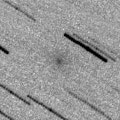
|
A comet discovered from the SOHO spacecraft images in 2003 was rediscovered from the STEREO spacecraft images. It was bright as 15.3 mag still in mid February (Feb. 19, Mitsunori Tsumura). However, the comet has already faded rapidly. It is not detected at all, fainter than 18.5 mag now (Mar. 5, Hidetaka Sato).
Date(TT) R.A. (2000) Decl. Delta r Elong. m1 Best Time(A, h)
Mar. 17 4 28.68 10 50.4 0.855 1.079 70 21.0 19:40 (131, 29)
Mar. 24 5 12.47 13 7.0 0.927 1.171 74 22.0 19:29 (138, 31)
|
|
![]()
 C/2009 P1 ( Garradd )
C/2009 P1 ( Garradd ) 21P/Giacobini-Zinner
21P/Giacobini-Zinner C/2012 C2 ( Bruenjes )
C/2012 C2 ( Bruenjes ) C/2011 Q2 ( McNaught )
C/2011 Q2 ( McNaught ) 78P/Gehrels 2
78P/Gehrels 2 (596) Scheila
(596) Scheila C/2011 F1 ( LINEAR )
C/2011 F1 ( LINEAR ) C/2009 F4 ( McNaught )
C/2009 F4 ( McNaught ) 29P/Schwassmann-Wachmann 1
29P/Schwassmann-Wachmann 1 71P/Clark
71P/Clark C/2006 S3 ( LONEOS )
C/2006 S3 ( LONEOS ) C/2011 A3 ( Gibbs )
C/2011 A3 ( Gibbs ) C/2010 M1 ( Gibbs )
C/2010 M1 ( Gibbs ) C/2010 G2 ( Hill )
C/2010 G2 ( Hill ) C/2011 R1 ( McNaught )
C/2011 R1 ( McNaught ) C/2010 S1 ( LINEAR )
C/2010 S1 ( LINEAR ) 246P/2010 V2 ( NEAT )
246P/2010 V2 ( NEAT ) C/2011 UF305 ( LINEAR )
C/2011 UF305 ( LINEAR ) C/2011 L4 ( PanSTARRS )
C/2011 L4 ( PanSTARRS ) C/2011 O1 ( LINEAR )
C/2011 O1 ( LINEAR ) 49P/Arend-Rigaux
49P/Arend-Rigaux C/2011 J2 ( LINEAR )
C/2011 J2 ( LINEAR ) C/2012 A2 ( LINEAR )
C/2012 A2 ( LINEAR ) C/2010 R1 ( LINEAR )
C/2010 R1 ( LINEAR ) 60P/Tsuchinshan 2
60P/Tsuchinshan 2 C/2012 CH17 ( MOSS )
C/2012 CH17 ( MOSS ) C/2005 L3 ( McNaught )
C/2005 L3 ( McNaught ) C/2011 S2 ( Kowalski )
C/2011 S2 ( Kowalski ) 117P/Helin-Roman-Alu 1
117P/Helin-Roman-Alu 1 105P/Singer Brewster
105P/Singer Brewster 240P/2010 P1 ( NEAT )
240P/2010 P1 ( NEAT ) 2008 YB3
2008 YB3 152P/Helin-Lawrence
152P/Helin-Lawrence P/2011 W2 ( Rinner )
P/2011 W2 ( Rinner ) 244P/2010 Q1 ( Scotti )
244P/2010 Q1 ( Scotti ) C/2011 W3 ( Lovejoy )
C/2011 W3 ( Lovejoy ) 164P/Christensen
164P/Christensen 123P/West-Hartley
123P/West-Hartley C/2011 Q4 ( SWAN )
C/2011 Q4 ( SWAN ) 255P/2011 Y1 ( Levy )
255P/2011 Y1 ( Levy ) 257P/2012 A3 ( SOHO )
257P/2012 A3 ( SOHO )![]()





































